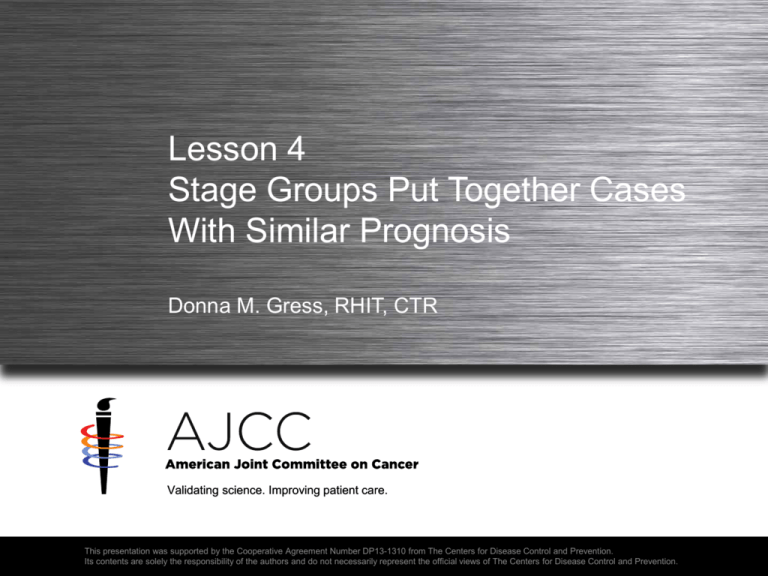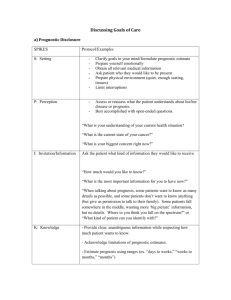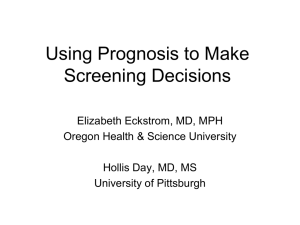
Lesson 4
Stage Groups Put Together Cases
With Similar Prognosis
Donna M. Gress, RHIT, CTR
Validating science. Improving patient care.
This presentation was supported by the Cooperative Agreement Number DP13-1310 from The Centers for Disease Control and Prevention.
Its contents are solely the responsibility of the authors and do not necessarily represent the official views of The Centers for Disease Control and Prevention.
Purpose of Stage Groups
• Reproducible and easily communicated summary of
staging information
• Patient care
– Helps patients understand the extent of their disease
– Communicate treatment and prognosis with patients
– Ease of communication between physicians
• Data analysis
– Larger numbers of similar patients
– Statistically significant
2
Copyright © 2015 AJCC All Rights Reserved
Creation of Stage Groups
• Basic premise – patients with similar prognosis
• Stage group made up of these categories
–
–
–
–
T
N
M
Can include other additional categories
• Group patients with similar prognosis
– Creates groups with specific category criteria
– Consolidates many combinations into a few groups
• Groups may contain
– Variance within categories, T1 N0 M0 and T2 N0 M0
– Variance between categories, T1 N1 M0 and T2 N0 M0
– As long as their outcomes are similar
3
Copyright © 2015 AJCC All Rights Reserved
Designation of Stage Groups
• Roman numerals I through IV
– Higher numbers indicate increasing severity
– 0 (zero) also used
• General meaning of stage groups, exceptions allowed
–
–
–
–
–
0 – in situ
I – small tumors, less deeply invasive, negative nodes
II – increasing tumor and nodal extent
III – increasing tumor and nodal extent
IV – distant metastasis
• Subsets
– Expand groupings using A, B, C
– More refined prognostic information
4
Copyright © 2015 AJCC All Rights Reserved
Meaning of Stage Groups
• Stage groups have prognostic meaning
– Must have statistically significant separation between stages
– Higher number stages must have worse prognosis than lower
numbers
– Not just split of cases between numbers I through IV
– Not just a range of better to worse and patients fit on that
continuum
• All cases within group have same outcome
– Even though their burden of disease may vary
5
Copyright © 2015 AJCC All Rights Reserved
Changes in Stage Groups
• Category combinations moved when outcomes change
• Must maintain separation between stages for outcomes
analysis
• Changes may be due to
– Improved clinical staging techniques better define the disease
– Improvements in treatment change prognosis in certain types
of involvement, for example
• New surgical techniques for local extent
• New systemic drugs for nodal involvement
6
Copyright © 2015 AJCC All Rights Reserved
Thank you
Donna M. Gress, RHIT, CTR
AJCC Technical Specialist
633 N. Saint Clair, Chicago, IL 6011-3211
cancerstaging.org
No materials in this presentation may be repurposed without the express written permission of the
American Joint Committee on Cancer. Permission requests may be submitted at CancerStaging.net












